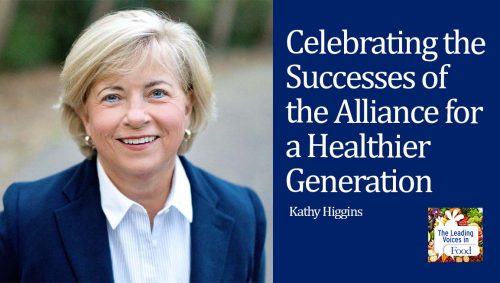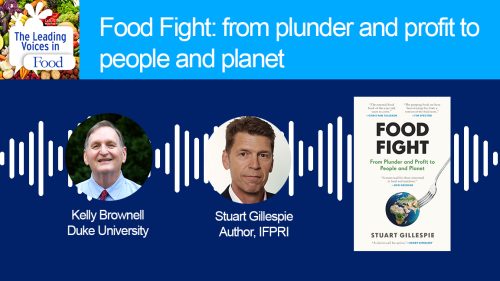The Leading Voices in Food
E254: Why is food so expensive?
If you feel like your grocery budget just doesn’t buy you as much as it once did, you’re not alone. According to U. S. Bureau of Labor Statistics, food prices rose 11. 4 percent last year alone – the highest annual increase in 23 years. The ongoing pinch at the grocery store has been in the news of a lot of media outlets, such as The Wall Street Journal, The New York Times, Times Magazine, Forbes, and so many others. Our guest today, food economics and policy professor David Ortega from Michigan State, is going to walk us through the food price inflation phenomenon.
Subscribe: Apple Podcasts | TuneIN | YouTube Music | SoundCloud | PocketCasts | Radio Public
Tags: COVID-19 Pandemic Impacts on Food | Economics of the food system | Food Industry Behavior & Marketing | History & Food |

David L. Ortega is a professor and the Noel W. Stuckman Chair in Food Economics and Policy at Michigan State University. His research program focuses on understanding consumer, producer, and agribusinesses decision-making to better inform food policies and marketing strategies. Dr. Ortega provides timely analysis of forces and events affecting the agricultural and food sectors. He has been called to provide expert testimony before federal and state agencies, including the U.S. Senate and House agriculture committees. He is a frequent contributor to food price inflation reporting at The New York Times and NPR, and is regularly interviewed by prominent media outlets, including ABC News, NBC News, PBS, USA Today, CNN, Forbes, Politico, The Wall Street Journal, Financial Times, Newsweek, and the Detroit Free Press, to name a few. Dr. Ortega earned his Ph.D. in Agricultural Economics from Purdue University.
Interview Summary
We’ve been hearing a lot about food price inflation. Can you tell us how food prices have changed over the last four to five years, and how that compares to the recent past?
Definitely. So, I think it’s always really important to define what food inflation is so that we’re all on the same page. We hear this word a lot and we’ve been hearing it for a number of years now. Inflation is the rate of increase in prices over a period of time – so how fast prices are changing or increasing in a given period. The time frame here is very, very important. Now, compared to last year, food prices are only up 2.1%. And this is for all food, which includes food at home and food away from home. Now groceries, food at home, are up 0.9% compared to last year. And menu prices at restaurants, or food away from home, are only 4.0% higher. Now if you’re listening to this, you’re probably thinking, ‘well, how can this be given how expensive things are at the grocery store?’ And that’s because you are likely thinking about how food prices have changed since the start of the pandemic, right? So, over the past five years, food prices have increased around 26%. And so that’s the cumulative effect of inflation that we’re all very familiar with at the grocery store.
Wow. You talked about the recent past, and in particular, about the time since COVID. How has this looked historically if you take a longer time frame?
Yes, so if we look at a few years before COVID, food prices generally increase around 2% or so, year over year. Now in the summer of 2022, we experienced double digit increases in food prices. More than 11%, year over year. And that was the highest rate of increase in around 40 years, since the late 1970s and early ’80s. So now that’s a significant spike and departure from what we would consider to be normal. But the rate of increase has come down to almost pre pandemic levels, which is really great news. But remember the rate of inflation is the rate of increase, so because that rate has come down, it doesn’t mean that prices are decreasing necessarily.
They’re just not growing as fast as they were before.
Correct.
I have some ideas, but I really want to hear you talk about it. What has led to this significant increase in the last four and a half years or so?
It’s really been a convergence of factors. It’s not just one particular thing, but really all these factors coming together and sort of compounding on each other. We saw increases in labor costs, and then as we go through the timeline, we had Russia’s invasion of Ukraine in February of 2022. And that really sent commodity prices surging for things like wheat, other grains, as well as vegetable oils. And it wasn’t just the invasion alone, but we had countries responding with export restrictions on things like palm oil that really just exacerbated the situation. We also have the impacts of climate change. The summer of 2022, and for a few years leading up to then, there was this mega drought in the West and the plain states that affected anything from lettuce prices to the price of meat. Something that we’re experiencing to this day. We also have the bird flu outbreak, now the largest outbreak in U. S. history. Egg prices have been through a bit of a roller coaster ride, and we’ve been hearing a lot about increases in egg prices. That’s primarily due to the high path avian influenza outbreak, or the bird flu outbreak.
Now, those are all what I would consider, for the most part, to be supply side factors. But we also have demand factors at play. And that is, that when we look at consumer spending on food, especially over the past two to three years, it’s been much higher compared to before the pandemic. Even when you adjust for inflation. Now, this is likely attributed to households. Some of them accumulated savings. We had the fiscal stimulus payments from the government that injected cash into the economy. For a period of time, some households, we could splurge at the grocery store. We’ve seen, and the data from USDA shows, that consumer spending on food both at home and away from home is much higher in recent years than prior to COVID. So again, it’s a combination of both supply side and demand side factors that have contributed to the significant rise in food prices.
This is a really important point that it’s not a single factor, but it’s this mix of things, which also makes it really difficult to talk about how to disentangle it. And I definitely want to hit on that. But before we get there, I want to know what has the impact of these significant price increases on consumers been?
The first thing that I want to point out is that food price inflation doesn’t impact everyone the same. It’s really low-income households that are hurt the most by these price increases. And that’s because they spend a higher share of their income on food. When we look at the poorest 20% of American households, they’re spending over a third of their income on food, compared to the average American household that spends roughly 10 to 12%. Now, when we look at industry data, we see that as a result of inflationary pressures, individuals are making shorter and more frequent trips to the grocery store. They’re doing more price comparisons. They’re turning and buying more of the private labels, the store brands, that sell at a much more affordable price point. And they’re buying fewer premium items. So less of the stocking up that we saw at the beginning of the pandemic. But this in turn can also fuel an increase in the price of those conventional or cheaper items. And that’s something that I found in the research that I’ve done on egg and poultry prices. When prices increase, consumers switch to the cheaper, more conventional items. And that increase in relative demand can put upward pressure on prices. So, we’ve seen this also reflected in the way that consumers are shopping for food and the prices that they’re seeing.
I think this is really critical for us to appreciate that while it is an often talked about issue, price inflation, and it does hurt lots of people, but appreciating that lower income folks are facing this at a much harder way is important. And, having spent time working with the charitable food sector and understanding the experiences of the individuals there, you’re regularly hearing people talk about the high price of food and how they’re trying to navigate it. And the role that these food pantries can play in helping meet that need, but it just still it’s a grind. It becomes really challenging.
Yeah.
Recent economic data actually shows that food price inflation is moderating. So, it’s not as hot as it once was. But consumers are still experiencing sticker shock at the grocery store. What’s going on here?
So, coming back to the earlier part of the conversation, people are really feeling the cumulative effects of inflation. And again, that’s why I find it very important to define inflation as the rate of increase in food prices. Well, the average consumer at the grocery store shopper, they don’t really care about the rate of increase. They care about the price level, right? When you see that eggs are $3-4 a dozen that’s going to catch your attention. When we look at the last 4, 4.5 years, food prices are up 25%. That’s a significant increase.
Now, another reason for this disconnect in terms of what the economic data is telling us and how consumers feel about food price inflation, is the nature of food prices in our interactions with them. We see food prices on a weekly if not more frequent basis. We know when prices are going up. We encounter food prices, we go grocery shopping, much more frequently than we get a haircut or we buy a plane ticket. We see these prices rise. Now, it’s also important, coming back to this discussion on the percent increase versus the price level, a 2% increase today is a higher dollar amount than it was a year ago, and certainly 5 years ago. Because the base has increased. It’s not just in the consumer psychology. It’s when we look at the price level and the increase. Prices are increasing more in terms of a dollar amount today than they were in the past. And so because of this, in many ways, the grocery store has really emerged as the face of inflation here in this country. And it really has impacted just about everybody over the past four or five years.
As someone who hasn’t had a haircut in probably 10 years, I really do know that prices have changed fairly quickly when it comes to food. But I don’t know what’s happening at the haircut. But I really appreciate this. And, but I think the thing that a lot of people struggle with in this conversation is, but inflation is coming down. We’ve just heard these reports and why aren’t food prices going down? But you’ve made it clear. It was almost like we’ve reached this high level. It is hard for it to roll back. I mean, we don’t expect prices to actually fall, do we?
When we look at specific items, right, it’s not uncommon to see, say, the price of eggs decrease when we have a period of low bird flu activity. But by and large, when we look at food as a category, say groceries, there have been some periods in the recent past where food prices decreased, say, 1-2% year over year. But we shouldn’t expect prices to decrease to the level that they were before COVID. And that’s because the nature of prices. They generally increase from year to year. And that’s a good thing as long as they are moderate increases. And as the data have been telling us for a couple of months now, we’re looking at food price increases in the neighborhood of what they were prior to the start of the COVID 19 Pandemic.
This is helpful. And it kind of makes me think of something we were talking about earlier. And so I want to ask you this last question. There’s been some conversation in policy circles about addressing this problem of food price inflation. What are your thoughts on how policy could be used to make a difference in this situation?
That’s an excellent question. We’re coming up on an election and there’s been proposals on both sides floating around and I appreciate the focus on an issue that is affecting consumers. But we have to look at the policies and what economic theory can tell us about what’s going to happen.
The first thing I’ll say before I even get to that is that the President of the United States, policymakers, have very little control over food prices, especially in the short term. We really have to look at sort of the longer time horizon. How can we make our food system more resilient to future shocks? Investing in crops that are drought tolerance, right? That climate change is one of the factors that’s going to be with us from here on out into the foreseeable future. We have to make those investments now so that we have a much more resilient food system in the future.
In terms of coming back to policies, we have to look at economic theory. There’s been proposals to ban, say, a price gouging at the federal level. That’s something that I think we have to look at very carefully because there could be some unintended consequences. This is just straight out of Econ 101. Other candidates have proposed tariffs across the board. We’ve seen what happened when we had the trade war with China back in 2018. It leads to even higher increases in food prices because food producers, food manufacturers, rely on inputs oftentimes from abroad. And so now they’re facing higher prices, they’re going to be passed on to the consumer. As we look at policies, I think it’s really important to look carefully at what some of the outcomes may be so that we don’t run into some unintended consequences.








